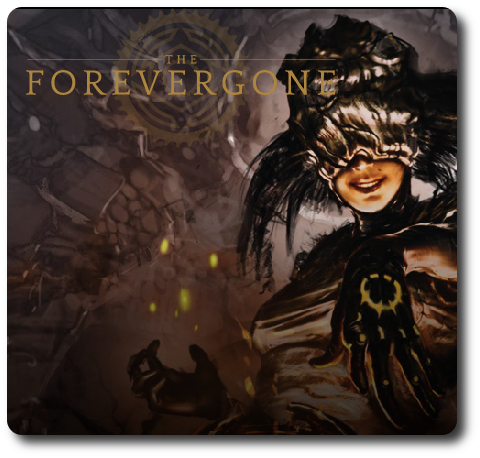
The Basics:
- For ages 8 and up (publisher suggests 12+)
- For 2 players (can expand to 4 players)
- Approximately 30 minutes to complete
Geek Skills:
- Active Listening & Communication
- Counting & Math
- Logical & Critical Decision Making
- Reading
- Strategy & Tactics
- Risk vs. Reward
- Hand/Resource Management
Learning Curve:
- Child – Moderate
- Adult – Easy
Theme & Narrative:
- From the ashes rises a new breed of mankind
Endorsements:
- Gamer Geek approved!
- Parent Geek approved!
- Child Geek mixed!
Overview
After a cataclysmic event demolishes civilization, humanity rises from the ashes to build anew. But not all that comes forth are completely human. Some have developed extraordinary and dangerous mental abilities. Feared and hated, these individuals hide in the shadows fighting for their survival. You are such an individual and your day of reckoning has come.
The Forevergone, designed by Rob Richmond and published via the Game Crafter, is comprised of of 100 Game cards, 4 collectible art cards, and 1 free music download card. The illustrations on the cards is outstanding, capturing the post-apocalyptic theme with a heavy dose of psionic badassness. The cards are as thick and as durable as your standard playing card. The bonus cards, the artwork and the free music download, have nothing to do with the game play. The free music download gives the player an opportunity to play the game with music being blasted in the background with The Forevergone game in mind. A nice touch.
From Out of Shadow
Note: The Forevergone is an expandable card game. All that is necessary to play a game with 2-players comes in the box. Up to 4 players can enjoy the game, but an additional set of cards must be purchased. Only the 2-player game is described here.
To set up the game, first separate the 100 Game cards by Discipline. There are 5 Disciplines in total and each Discipline contains 20 Game cards. Use the Discipline icons shown on the card face to quickly complete this task.
Second, decide who will be the first player and have that individual select 1 of the 5 Disciplines, taking all 20 cards of that type. The second player now selects their Discipline of choice. These are the player’s Primary Discipline.
Third, repeat the second step, but the selected Discipline is the players’ Secondary Discipline. Remove all Discipline Level 3 valued Secondary Discipline cards from the game. These will not be used.
Fourth, players now shuffle their Primary an Secondary Disciplines together and place the deck of cards face-down in front of them. This is the player’s draw deck, commonly referred to as the Ether.
That’s it for game set up. Have each player draw the top 6 cards from their draw deck to create their initial hand of cards. Remove any other Disciplines not selected from the game.
The Maze of the Mind
There are 5 different Disciplines in the game. Each is unique and provides the player different ways and means to conquer their opponent. Each of the Disciplines are summarized here.
- Illusionist: Through the use of illusion, holographic technology, and misdirection, the player is able to duck, dodge, and manage the amount of damage they take.
- Egoist: Firmly rooted abilities in the preservation of the self.
- Kineticist: A Discipline grounded in the belief that brute force makes right.
- Telepath: Preferring a more subtle approach, this Discipline whittles opponents down, slowly crippling them.
- Seer: A rare and powerful Discipline that allows an individual to subtly adjust the events of the future and the past.
Combining two Disciplines gives the player a lot of opportunities and options. Ultimately, how offensively and defensively the player needs to act is based on their opponent and the player’s own personal tactics. No single Discipline is better than another, but each does have their own unique advantages.
The Cards
Each game card is the same regarding layout. This makes learning how to play the game very easy, as the player isn’t required to learn a great deal up front.
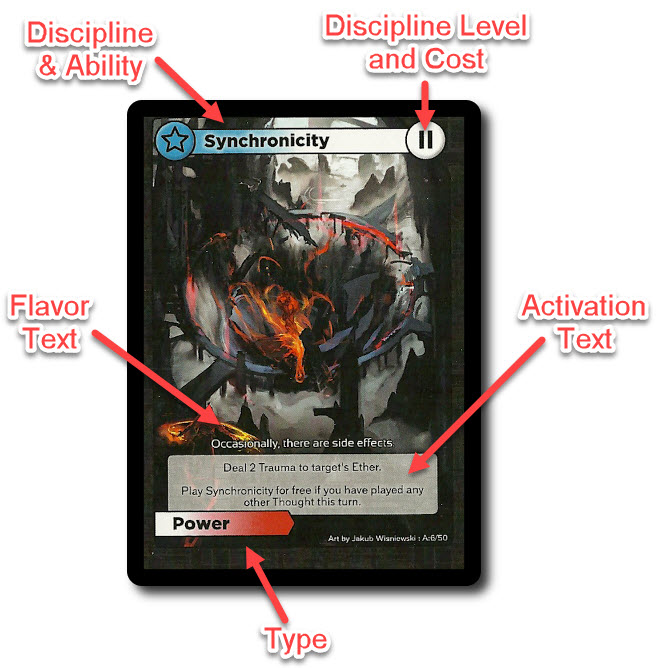
There are only 3 card types that break down each Discipline into specific areas of focus.
Power Cards
Power cards are the most basic and abundant in the player’s deck. They can only be used on the player’s turn.
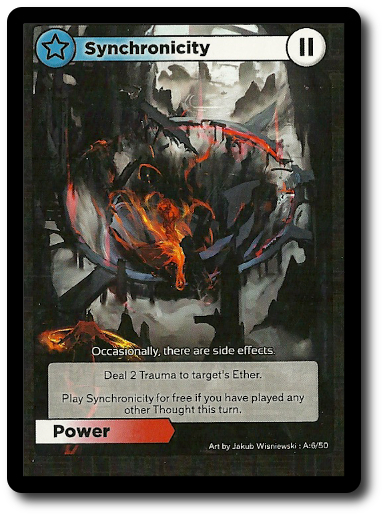
Reaction Cards
Reaction cards can be activated anytime during the game, but only in response to an opponent’s card play. A player is never required to play a card as a reaction.
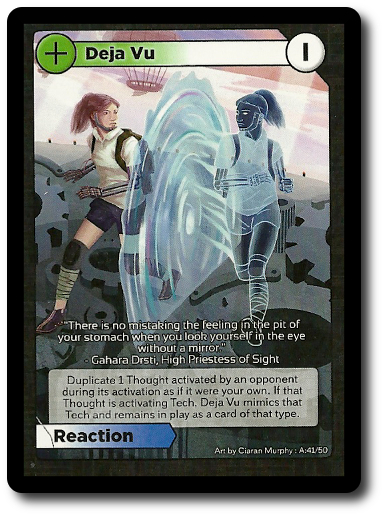
Tech
While the mind is a powerful tool, technology can be used to augment the player’s mental powers. Tech is played on the player’s turn and remain in play, providing bonuses until the game is over or the card is removed from the game. Only 3 Tech cards can be used by the player at a time. Bringing out a fourth will force the player to deactivate previously played Tech cards.
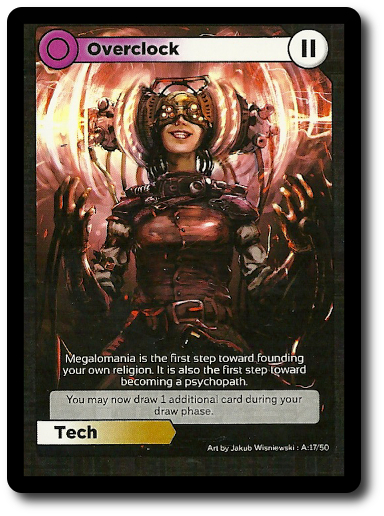
It’s All In Your Head
The Forevergone is played in turns with no set number of turns per game. Each player’s turn is comprised of a small number of sequential steps that are summarized here.
Step 1: Deactivate Tech and Draw Cards
If the player has any Tech cards in play, they may deactivate them now at no cost. Deactivated Tech cards go into the player’s “positive” discard pile referred to as the player’s Memory. It’s considered a positive discard pile because the cards that go in it will return to the player and do not directly hinder the player’s ability to win the game.
Then the player draws 3 cards from their draw deck, adding them to their hand.
Step 2: Activate
Activating Tech and Power cards requires the player to be able to pay for the card’s. The cost is listed on the card and will either be a value of “1”, “2”, or “3”. To bring the card into play, a number of cards in the player’s hand equal to the card to be activated cost must be placed face-down in the player’s Memory discard pile. The player then places their newly activated card face-up in front of them. If the card activated was a Tech card, it’s placed next to any other Tech cards in front of the player.
Only 1 card can be activated per turn.
Step 3: Reactions and Resolution
Any player now has an opportunity to play a Reaction card or cards. The cost must be paid using the same method to activate a card.
Reaction cards played have an order in which they are resolved. When played, they are “stacked” on top of the card played during step 2 and any Reaction cards played before it. When the cards are done being played, the stack is resolved from the top down. This means cards will counter, alter, and cancel the previous resolved card. Maybe. Depends on the order in which they were played.
If the cards are resolved with a positive effect, they are returned to the player and go in their Memory discard pile. If the card effect damages the player, they are placed in the negative discard pile referred to as the player’s Trauma. This is a bad place to discard cards, as the Trauma discard pile is used to determine who is winning the game. The more Trauma the player has, the more likely they are to lose.
Step 4: Additional Activations
The player may now repeat step 2 if they have additional cards they want to activate. This step is optional.
Step 5: End of Turn
The player’s turn is now over. They discard down to 8 cards, placing the discarded cards in their Trauma discard pile. The player then counts the total number of cards in their Trauma discard pile. If the player has not lost, their turn is over and the next player now goes.
Brain Boss
The first player to have 15 or more cards in their Trauma discard pile loses the game. Their character collapses to the ground, mentally exhausted and broken. The other player is the winner, wiser and more adept in the ways of mental combat than ever before.
To learn more about The Forevergone, visit the game’s website.
Final Thought
The Child Geeks really liked the game’s concept and its artwork. They spent the first 15 minutes of the game just looking through the cards, commenting on what they saw, and arguing about what Discipline would be the best. When they actually started playing the game, we began to run into problems. First, the Child Geeks didn’t like how their cards were being used. They blamed it on their Discipline selection, but I think it was really based on their lack of understanding of the cards themselves. According to one Child Geek, “I like the game, but it’s also kind of frustrating. I don’t really get what cards I should keep or use for powering other cards.” And that, actually, is the real challenge of the game. There is no “bad card” in the player’s hand. Everything is useful. Either as an action, reaction, or powering one of the two. According to another Child Geek, “A neat game, but I can tell if it’s going to take me a long time to get good at it.” Which is not to say the Child Geeks couldn’t play the game right off the bat. They could and a number of them were very good, but the learning curve is one that can only be fully addressed by time playing the game, exploring its options, and mixing different cards. That sounded like more work than the Child Geeks wanted to put into it. When the games were over, the Child Geeks gave The Forevergone a mixed level of approval.
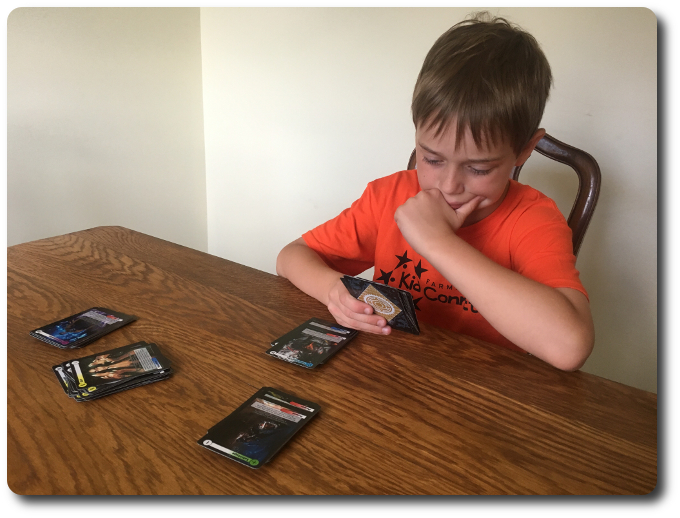
My son carefully considers his Primary Discipline and fate…
The Parent Geeks liked how the game was played and had no problem understanding the subtle card interaction. As one Parent Geek put it, “I like it. It feels small, but the game play is actually pretty in-depth. I don’t think this will be a game I take overly seriously, but I’m really enjoying my time playing it.” The Forevergone was enjoyed most by the Parent Geeks who had played games a great deal and were now more casual players due to lack of time. Non-gamers had difficulty understanding the point of the game, other than just winning. According to one of these Non-Gamer Parent Geeks, “I don’t get the game’s theme. I don’t get the game’s terminology. I do understand how to play it, though, so that’s a big plus.” When the games were over, the Parent Geeks voted to approve The Forevergone, finding it to be a game that required just the right mix of tactics, strategy, and imagination.
The Gamer Geeks enjoyed many of the game’s mechanics. For example, they liked that the cards were both used as actions and as the fuel to power the actions. As one Gamer Geek put it, “This forces you to carefully consider which cards to use and when.” The Gamer Geeks also liked how the game allowed players to create killer chains and combos by stacking Reaction cards. According to one Gamer Geek, “A really neat idea that forces players to carefully consider the order in which their cards are played, which cards to use to power them, and when to hold off and wait for better openings.” The Gamer Geeks even liked how the game punished players for “overloading” their deck. In fact, there was nothing about the game the Gamer Geeks didn’t enjoy. From thematic feel to strategic game play, the Gamer Geeks didn’t hesitate to give The Forevergone their full approval.
I didn’t find the game to be overly imaginative in its theme, but I very much enjoyed how it was played. I liked the idea of players selecting their Disciplines up front and then doing everything they could to mix and match their primary and secondary to come out on top. While not a deck-building game by any means, the selection of Disciplines at the very first sets the stage for the entire game. Selection of the right combination of Discipline is not essential to victory, but each pairing opens pros and cons that can be exploited. A unique and very interesting approach that is both elegant in its execution and difficult to master.
There is a learning curve here. If the player selects two Disciplines that are primarily passive their approach to dominating the enemy, they will succumb rather quickly to a more aggressive opponent slinging cards from a Discipline that is all about in your face combat. This means a player will have to learn through trial and error, mixing and remixing Disciplines until they come up with a combo that works from them. And here we encounter a problem with the game. There are only so many Disciplines to go around. No two Disciplines will encounter each other on the battlefield. The solution, however, is obvious, if not simple. The player must have a Plan B. Of course, this is only necessary if the game is played often. If it isn’t, then random selection of Disciplines works just fine, although it breaks the spirit of the game to a certain degree.
This game is all about causing pain and that also requires sacrifice on the player’s part. For example, there is a card that allows the player to either cause Trauma at the cost of losing a card or not touching the opponent at all and saving the card for later. Since the game is all about causing as much pain as possible as quickly as possible, it would seem that the obvious choice would be to ditch the card to cause pain, but that would force the player to never see the card again, reducing their own ability to defend and attack in the future. Many of the cards pose a conundrum to the player. What cards to play and when is already sometimes difficult to determine. Add in additional level of sacrifice and self-preservation, and you have a game that can be a real thinker at times.
I was very pleased with The Forevergone. For a small game, it gave our players a lot of fun at the gaming table. It’s difficult to say if The Forevergone is a casual game or even a filler, as the level of thought necessary to process the next step is sometimes surprisingly advanced. Other times, a player’s turn is as unimaginative as a blank wall. It all comes down to the cards in the player’s hand and the previous turn. Actions and reactions are at the core of The Forevergone, challenging players to think both forward and backwards to make the best possible choice to survive just one more round. Do try this card game when time permits. While it won’t melt your mind, it will most certainly make you furrow your brow in delightful contemplation.
This is a paid for review of the game’s final prototype. Although our time and focus was financially compensated, our words are our own. We’d need at least 10 million dollars before we started saying what other people wanted. Such is the statuesque and legendary integrity of Father Geek which cannot be bought except by those who own their own private islands and small countries.



